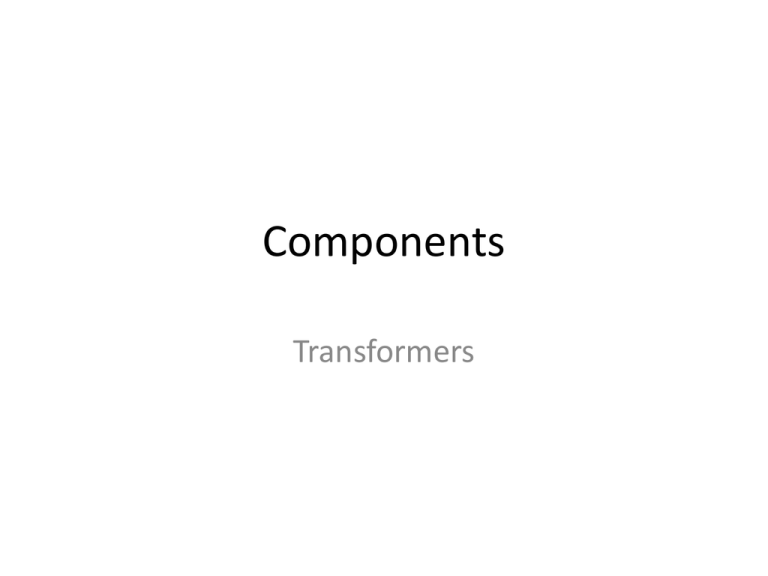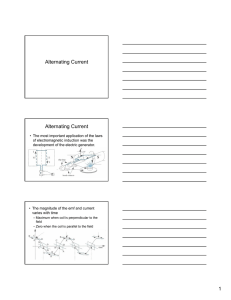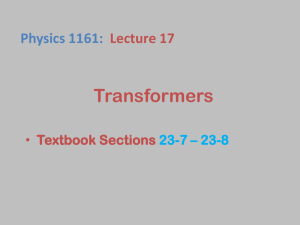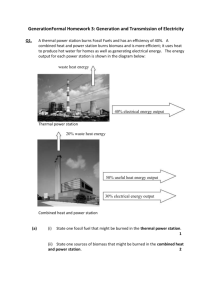Transformers
advertisement

Components Transformers Transformers How does a transformer work? A transformer is based on a simple fact about electricity: when a fluctuating electric current flows through a wire, it generates a magnetic field (an invisible pattern of magnetism) or "magnetic flux" all around it. The strength of the magnetism (which has the rather technical name of magnetic flux density) is directly related to the size of the electric current. The larger amount of current, the stronger the magnetic field. When a magnetic field fluctuates around a piece of wire, it generates an electric current in the wire. So if we put a second coil of wire next to the first one, and send a fluctuating electric current into the first coil, we will create an electric current in the second wire. Transformers The current in the first coil is usually called the primary current and the current in the second wire is the secondary current. What we've done here is pass an electric current through empty space from one coil of wire to another. This is called electromagnetic induction because the current in the first coil causes (or "induces") a current in the second coil. We can make electrical energy pass more efficiently from one coil to the other by wrapping them around a soft iron bar (called a core). Transformers Transformers To make a coil of wire, we simply curl the wire round into loops or "turns". If the second coil has the same number of turns as the first coil, the current in the second coil will be virtually the same size as the one in the first coil. But (and here's the clever part) if we have more or fewer turns in the second coil, we can make the secondary current and voltage bigger or smaller than the primary current and voltage. One important thing to note is that this trick works only if the current is fluctuating in some way. In other words, you have to use a type of constantly reversing electricity called alternating current (AC) with a transformer. Transformers do not work with direct current (DC), where a steady current constantly flows in the same direction. Transformers Step-down transformers If the first coil has more turns that the second coil, the secondary voltage is smaller than the primary voltage: This is called a step-down transformer. If the second coil has half as many turns as the first coil, the secondary voltage will be half the size of the primary voltage; if the second coil has one tenth as many turns it has one tenth the voltage. Transformers Transformers So a step-down transformer with 100 coils in the primary and 10 coils in the secondary will reduce the voltage by a factor of 10 but multiply the current by a factor of 10 at the same time. The power is equal to the current times the voltage (watts = volts x amps is one way to remember this), so you can see the power in the secondary coil is theoretically the same as the power in the primary coil. (In reality, there is some loss of power between the primary and the secondary because some of the "magnetic flux" leaks out of the core, some energy is lost because the core heats up, and so on.) Transformers Step-up transformers Reversing the situation, we can make a step-up transformer that boosts a low voltage into a high one: Transformers Transformers Transformers in the home There are huge transformers in towns and cities where the highvoltage electricity from incoming power lines is converted into lower-voltages. There are transformers in your home as well. Electric appliances such as washing machines and dishwashers use voltages of 110-240 volts, but electronic devices (laptop computers and chargers for MP3 players and mobile cellphones) use lower voltages: a laptop needs about 15 volts, an iPod charger needs 12 volts, and a cellphone typically needs less than 6 volts when you charge up its battery. Thus, electronic appliances like these have small transformers built into them (often mounted at the end of the power lead) to convert the 110-240 volt domestic supply into a smaller voltage they can use. Transformers Photo: Typical home transformers. Anticlockwise from top left: A modern transformer, the white transformer in an iPod charger, and a cellphone charger. Transformers Induction chargers What happens with an electric toothbrush, which has no power lead? It charges up with a slightly different type of transformer, which has one of its coils in the base of the brush and the other in the charger that the brush stands on. You can read more about how it works in our article about induction chargers. Photo: An electric toothbrush standing on its induction charger. The battery in the brush charges up by induction: there is no direct electrical contact between the plastic brush and the plastic charger unit in the base. Transformers Transformers on the Electrical Grid Let's look at the electricity that comes to your home. When electricity moves from a power plant it is put into a very high voltage to be able to travel long distances. The high voltage lines can be as high 155,000 to 765,000 volts to travel many hundreds of miles. In order for your home or a store to use the electricity, it has to be at a lower voltage than on the long-distance lines. So, the electricity is "stepped-down to a lower level using a transformer. This lower voltage electricity is put into the local electric wires at a substation. The substation breaks the larger amount of power down into smaller pieces at lower voltage. It then is stepped down again and again. Once smaller transformers take that voltage down to usually 7,200, the power leaves this substation. Transformers In your neighborhood, a transformer on top of a utility pole, or one connected to underground wires, transforms the 7,200 volts into 220-240 volts. This is then sent into your home over three wires. The three wires go through the electric meter, which measures how much electricity you use. One of the three wires is the ground, and the other two are the positives. Transformers Some of the electrical appliances in your home use the 220-240 volts. These are things like a water heater, stove and oven, or air conditioner. They have very special connections and plugs. Other devices, like your TV or computer only use one-half of the electricity - 110-120 volts. In a toy train set, the voltage is reduced even more from 110-120 and is changed from alternating current into direct current.



